Leadership and Organizational Behavior: Toyota vs. Ford Analysis
VerifiedAdded on 2020/01/16
|15
|4516
|199
Report
AI Summary
This report provides a comprehensive analysis of the organizational behavior, leadership styles, and structures of Toyota and Ford. It begins by comparing and contrasting their organizational structures and cultures, highlighting the impact on performance. The report then examines the relationship between structure and culture, and the factors influencing individual behavior. Further, it delves into the effectiveness of different leadership styles, organizational theory, and various approaches to management employed by both companies. The report also discusses the impact of leadership styles on motivation, compares motivational theories, and evaluates their usefulness for managers. Additionally, it explores group dynamics, teamwork factors, and the impact of technology on team functioning within Toyota. The conclusion summarizes the key findings, offering valuable insights into the management practices of these two automotive giants.
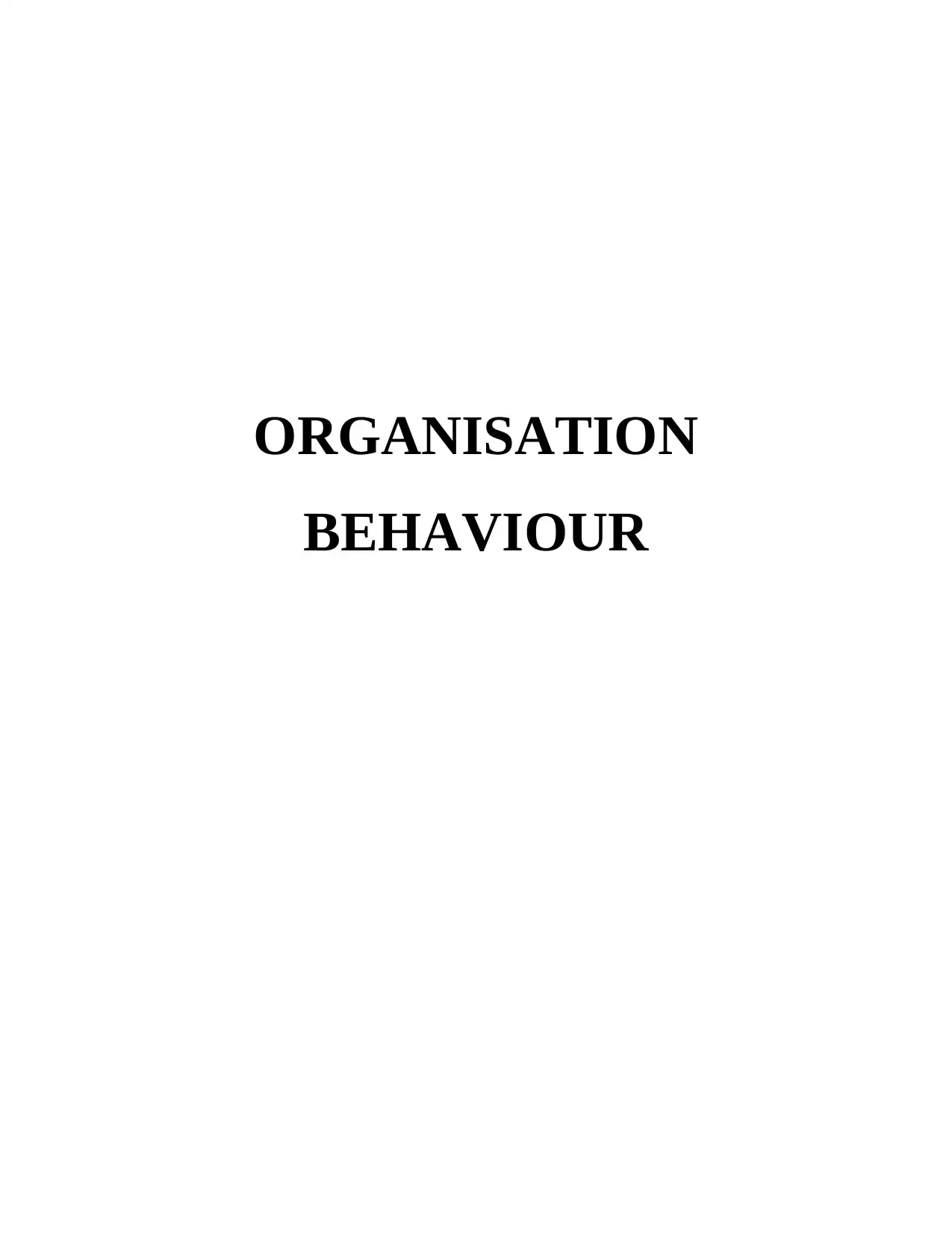
ORGANISATION
BEHAVIOUR
BEHAVIOUR
Paraphrase This Document
Need a fresh take? Get an instant paraphrase of this document with our AI Paraphraser
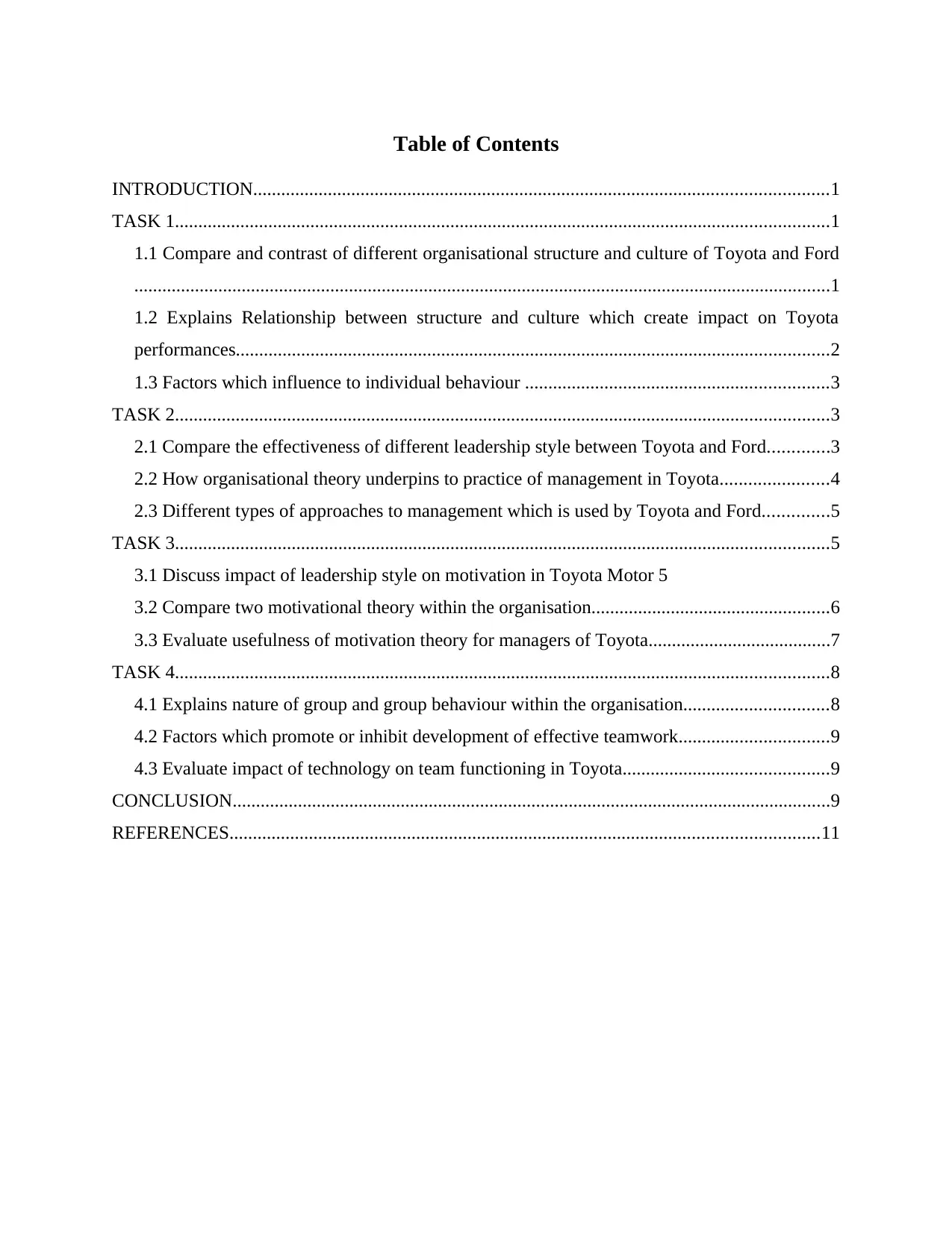
Table of Contents
INTRODUCTION...........................................................................................................................1
TASK 1............................................................................................................................................1
1.1 Compare and contrast of different organisational structure and culture of Toyota and Ford
.....................................................................................................................................................1
1.2 Explains Relationship between structure and culture which create impact on Toyota
performances...............................................................................................................................2
1.3 Factors which influence to individual behaviour .................................................................3
TASK 2............................................................................................................................................3
2.1 Compare the effectiveness of different leadership style between Toyota and Ford.............3
2.2 How organisational theory underpins to practice of management in Toyota.......................4
2.3 Different types of approaches to management which is used by Toyota and Ford..............5
TASK 3............................................................................................................................................5
3.1 Discuss impact of leadership style on motivation in Toyota Motor 5
3.2 Compare two motivational theory within the organisation...................................................6
3.3 Evaluate usefulness of motivation theory for managers of Toyota.......................................7
TASK 4............................................................................................................................................8
4.1 Explains nature of group and group behaviour within the organisation...............................8
4.2 Factors which promote or inhibit development of effective teamwork................................9
4.3 Evaluate impact of technology on team functioning in Toyota............................................9
CONCLUSION................................................................................................................................9
REFERENCES..............................................................................................................................11
INTRODUCTION...........................................................................................................................1
TASK 1............................................................................................................................................1
1.1 Compare and contrast of different organisational structure and culture of Toyota and Ford
.....................................................................................................................................................1
1.2 Explains Relationship between structure and culture which create impact on Toyota
performances...............................................................................................................................2
1.3 Factors which influence to individual behaviour .................................................................3
TASK 2............................................................................................................................................3
2.1 Compare the effectiveness of different leadership style between Toyota and Ford.............3
2.2 How organisational theory underpins to practice of management in Toyota.......................4
2.3 Different types of approaches to management which is used by Toyota and Ford..............5
TASK 3............................................................................................................................................5
3.1 Discuss impact of leadership style on motivation in Toyota Motor 5
3.2 Compare two motivational theory within the organisation...................................................6
3.3 Evaluate usefulness of motivation theory for managers of Toyota.......................................7
TASK 4............................................................................................................................................8
4.1 Explains nature of group and group behaviour within the organisation...............................8
4.2 Factors which promote or inhibit development of effective teamwork................................9
4.3 Evaluate impact of technology on team functioning in Toyota............................................9
CONCLUSION................................................................................................................................9
REFERENCES..............................................................................................................................11

⊘ This is a preview!⊘
Do you want full access?
Subscribe today to unlock all pages.

Trusted by 1+ million students worldwide
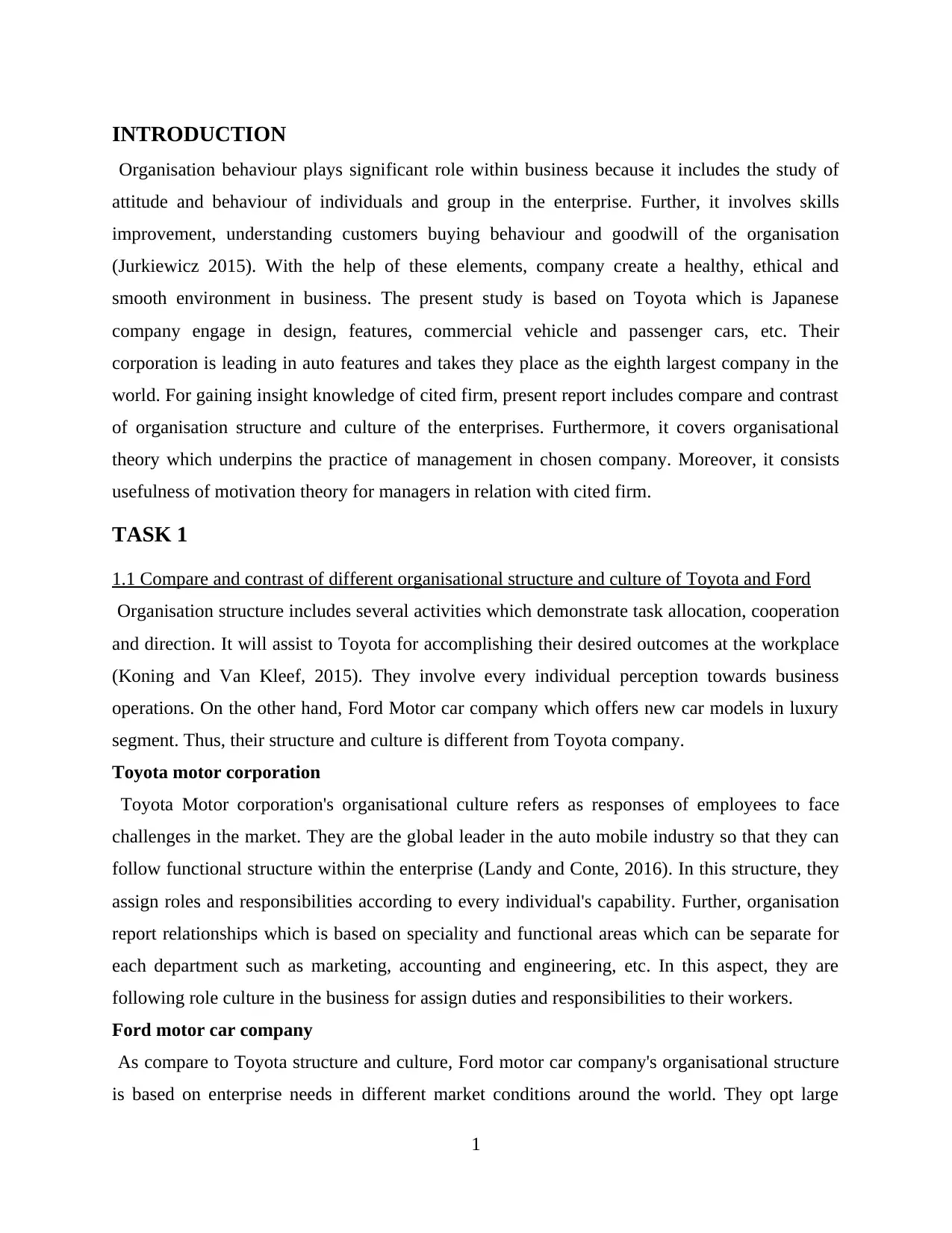
INTRODUCTION
Organisation behaviour plays significant role within business because it includes the study of
attitude and behaviour of individuals and group in the enterprise. Further, it involves skills
improvement, understanding customers buying behaviour and goodwill of the organisation
(Jurkiewicz 2015). With the help of these elements, company create a healthy, ethical and
smooth environment in business. The present study is based on Toyota which is Japanese
company engage in design, features, commercial vehicle and passenger cars, etc. Their
corporation is leading in auto features and takes they place as the eighth largest company in the
world. For gaining insight knowledge of cited firm, present report includes compare and contrast
of organisation structure and culture of the enterprises. Furthermore, it covers organisational
theory which underpins the practice of management in chosen company. Moreover, it consists
usefulness of motivation theory for managers in relation with cited firm.
TASK 1
1.1 Compare and contrast of different organisational structure and culture of Toyota and Ford
Organisation structure includes several activities which demonstrate task allocation, cooperation
and direction. It will assist to Toyota for accomplishing their desired outcomes at the workplace
(Koning and Van Kleef, 2015). They involve every individual perception towards business
operations. On the other hand, Ford Motor car company which offers new car models in luxury
segment. Thus, their structure and culture is different from Toyota company.
Toyota motor corporation
Toyota Motor corporation's organisational culture refers as responses of employees to face
challenges in the market. They are the global leader in the auto mobile industry so that they can
follow functional structure within the enterprise (Landy and Conte, 2016). In this structure, they
assign roles and responsibilities according to every individual's capability. Further, organisation
report relationships which is based on speciality and functional areas which can be separate for
each department such as marketing, accounting and engineering, etc. In this aspect, they are
following role culture in the business for assign duties and responsibilities to their workers.
Ford motor car company
As compare to Toyota structure and culture, Ford motor car company's organisational structure
is based on enterprise needs in different market conditions around the world. They opt large
1
Organisation behaviour plays significant role within business because it includes the study of
attitude and behaviour of individuals and group in the enterprise. Further, it involves skills
improvement, understanding customers buying behaviour and goodwill of the organisation
(Jurkiewicz 2015). With the help of these elements, company create a healthy, ethical and
smooth environment in business. The present study is based on Toyota which is Japanese
company engage in design, features, commercial vehicle and passenger cars, etc. Their
corporation is leading in auto features and takes they place as the eighth largest company in the
world. For gaining insight knowledge of cited firm, present report includes compare and contrast
of organisation structure and culture of the enterprises. Furthermore, it covers organisational
theory which underpins the practice of management in chosen company. Moreover, it consists
usefulness of motivation theory for managers in relation with cited firm.
TASK 1
1.1 Compare and contrast of different organisational structure and culture of Toyota and Ford
Organisation structure includes several activities which demonstrate task allocation, cooperation
and direction. It will assist to Toyota for accomplishing their desired outcomes at the workplace
(Koning and Van Kleef, 2015). They involve every individual perception towards business
operations. On the other hand, Ford Motor car company which offers new car models in luxury
segment. Thus, their structure and culture is different from Toyota company.
Toyota motor corporation
Toyota Motor corporation's organisational culture refers as responses of employees to face
challenges in the market. They are the global leader in the auto mobile industry so that they can
follow functional structure within the enterprise (Landy and Conte, 2016). In this structure, they
assign roles and responsibilities according to every individual's capability. Further, organisation
report relationships which is based on speciality and functional areas which can be separate for
each department such as marketing, accounting and engineering, etc. In this aspect, they are
following role culture in the business for assign duties and responsibilities to their workers.
Ford motor car company
As compare to Toyota structure and culture, Ford motor car company's organisational structure
is based on enterprise needs in different market conditions around the world. They opt large
1
Paraphrase This Document
Need a fresh take? Get an instant paraphrase of this document with our AI Paraphraser
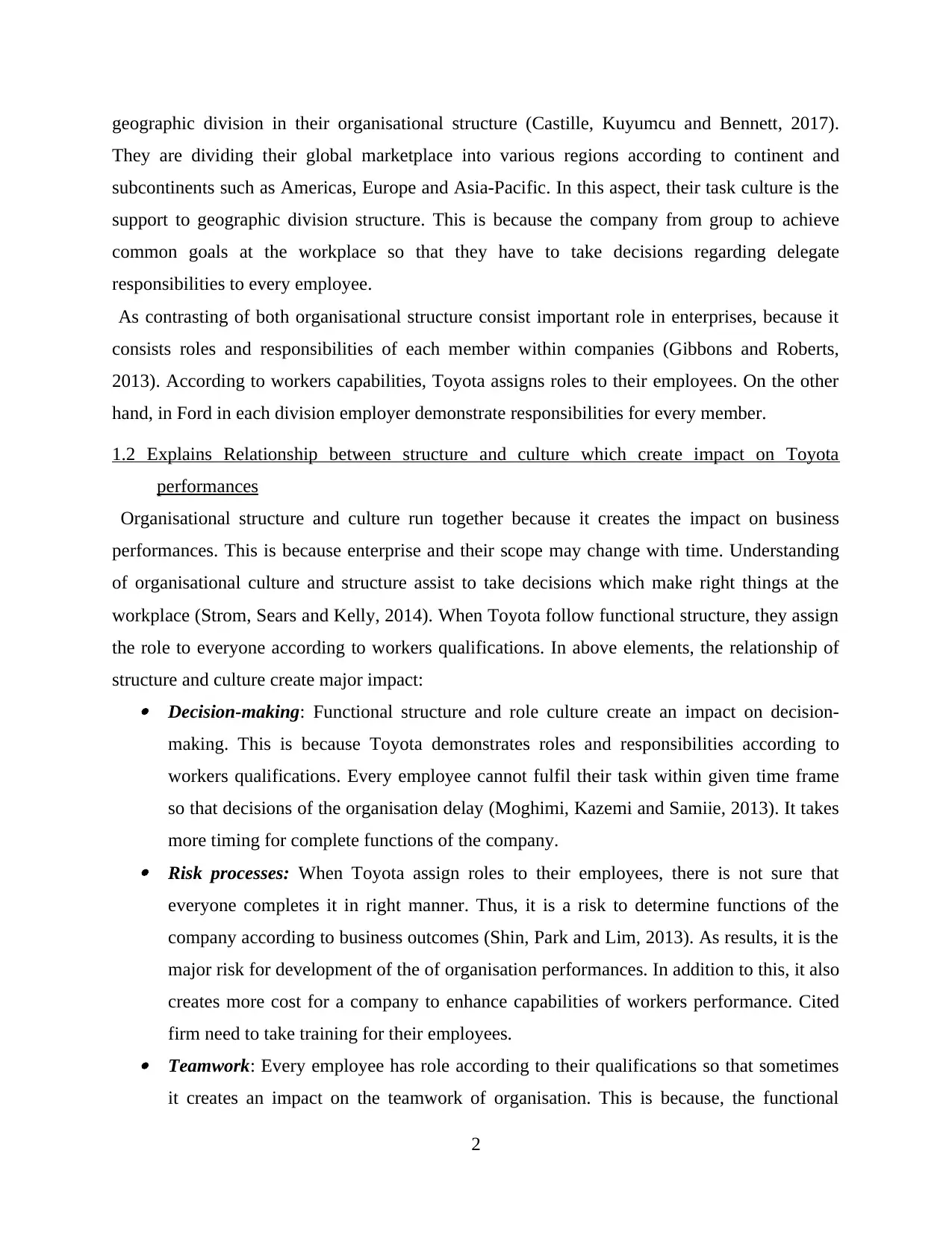
geographic division in their organisational structure (Castille, Kuyumcu and Bennett, 2017).
They are dividing their global marketplace into various regions according to continent and
subcontinents such as Americas, Europe and Asia-Pacific. In this aspect, their task culture is the
support to geographic division structure. This is because the company from group to achieve
common goals at the workplace so that they have to take decisions regarding delegate
responsibilities to every employee.
As contrasting of both organisational structure consist important role in enterprises, because it
consists roles and responsibilities of each member within companies (Gibbons and Roberts,
2013). According to workers capabilities, Toyota assigns roles to their employees. On the other
hand, in Ford in each division employer demonstrate responsibilities for every member.
1.2 Explains Relationship between structure and culture which create impact on Toyota
performances
Organisational structure and culture run together because it creates the impact on business
performances. This is because enterprise and their scope may change with time. Understanding
of organisational culture and structure assist to take decisions which make right things at the
workplace (Strom, Sears and Kelly, 2014). When Toyota follow functional structure, they assign
the role to everyone according to workers qualifications. In above elements, the relationship of
structure and culture create major impact: Decision-making: Functional structure and role culture create an impact on decision-
making. This is because Toyota demonstrates roles and responsibilities according to
workers qualifications. Every employee cannot fulfil their task within given time frame
so that decisions of the organisation delay (Moghimi, Kazemi and Samiie, 2013). It takes
more timing for complete functions of the company. Risk processes: When Toyota assign roles to their employees, there is not sure that
everyone completes it in right manner. Thus, it is a risk to determine functions of the
company according to business outcomes (Shin, Park and Lim, 2013). As results, it is the
major risk for development of the of organisation performances. In addition to this, it also
creates more cost for a company to enhance capabilities of workers performance. Cited
firm need to take training for their employees. Teamwork: Every employee has role according to their qualifications so that sometimes
it creates an impact on the teamwork of organisation. This is because, the functional
2
They are dividing their global marketplace into various regions according to continent and
subcontinents such as Americas, Europe and Asia-Pacific. In this aspect, their task culture is the
support to geographic division structure. This is because the company from group to achieve
common goals at the workplace so that they have to take decisions regarding delegate
responsibilities to every employee.
As contrasting of both organisational structure consist important role in enterprises, because it
consists roles and responsibilities of each member within companies (Gibbons and Roberts,
2013). According to workers capabilities, Toyota assigns roles to their employees. On the other
hand, in Ford in each division employer demonstrate responsibilities for every member.
1.2 Explains Relationship between structure and culture which create impact on Toyota
performances
Organisational structure and culture run together because it creates the impact on business
performances. This is because enterprise and their scope may change with time. Understanding
of organisational culture and structure assist to take decisions which make right things at the
workplace (Strom, Sears and Kelly, 2014). When Toyota follow functional structure, they assign
the role to everyone according to workers qualifications. In above elements, the relationship of
structure and culture create major impact: Decision-making: Functional structure and role culture create an impact on decision-
making. This is because Toyota demonstrates roles and responsibilities according to
workers qualifications. Every employee cannot fulfil their task within given time frame
so that decisions of the organisation delay (Moghimi, Kazemi and Samiie, 2013). It takes
more timing for complete functions of the company. Risk processes: When Toyota assign roles to their employees, there is not sure that
everyone completes it in right manner. Thus, it is a risk to determine functions of the
company according to business outcomes (Shin, Park and Lim, 2013). As results, it is the
major risk for development of the of organisation performances. In addition to this, it also
creates more cost for a company to enhance capabilities of workers performance. Cited
firm need to take training for their employees. Teamwork: Every employee has role according to their qualifications so that sometimes
it creates an impact on the teamwork of organisation. This is because, the functional
2
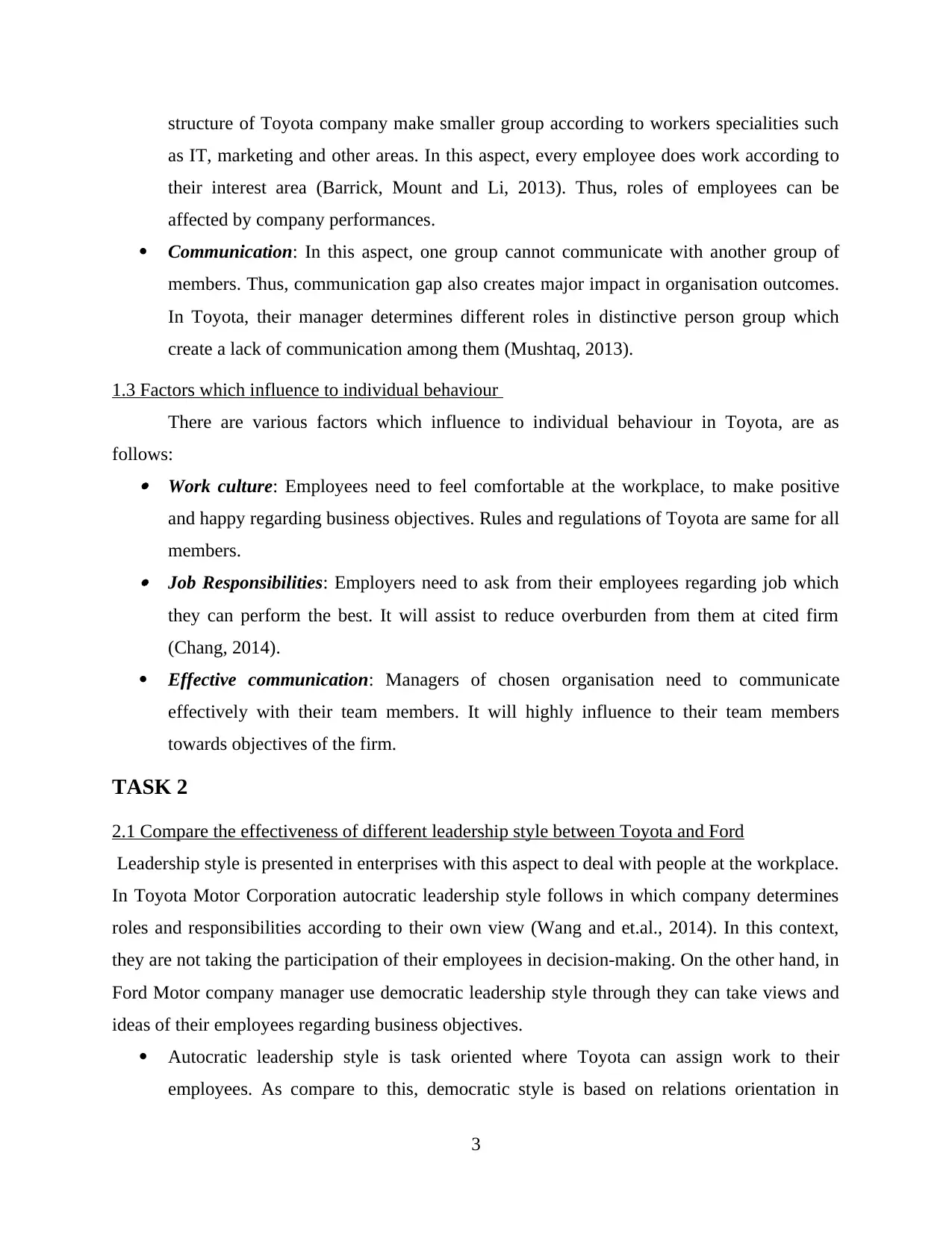
structure of Toyota company make smaller group according to workers specialities such
as IT, marketing and other areas. In this aspect, every employee does work according to
their interest area (Barrick, Mount and Li, 2013). Thus, roles of employees can be
affected by company performances.
Communication: In this aspect, one group cannot communicate with another group of
members. Thus, communication gap also creates major impact in organisation outcomes.
In Toyota, their manager determines different roles in distinctive person group which
create a lack of communication among them (Mushtaq, 2013).
1.3 Factors which influence to individual behaviour
There are various factors which influence to individual behaviour in Toyota, are as
follows: Work culture: Employees need to feel comfortable at the workplace, to make positive
and happy regarding business objectives. Rules and regulations of Toyota are same for all
members. Job Responsibilities: Employers need to ask from their employees regarding job which
they can perform the best. It will assist to reduce overburden from them at cited firm
(Chang, 2014).
Effective communication: Managers of chosen organisation need to communicate
effectively with their team members. It will highly influence to their team members
towards objectives of the firm.
TASK 2
2.1 Compare the effectiveness of different leadership style between Toyota and Ford
Leadership style is presented in enterprises with this aspect to deal with people at the workplace.
In Toyota Motor Corporation autocratic leadership style follows in which company determines
roles and responsibilities according to their own view (Wang and et.al., 2014). In this context,
they are not taking the participation of their employees in decision-making. On the other hand, in
Ford Motor company manager use democratic leadership style through they can take views and
ideas of their employees regarding business objectives.
Autocratic leadership style is task oriented where Toyota can assign work to their
employees. As compare to this, democratic style is based on relations orientation in
3
as IT, marketing and other areas. In this aspect, every employee does work according to
their interest area (Barrick, Mount and Li, 2013). Thus, roles of employees can be
affected by company performances.
Communication: In this aspect, one group cannot communicate with another group of
members. Thus, communication gap also creates major impact in organisation outcomes.
In Toyota, their manager determines different roles in distinctive person group which
create a lack of communication among them (Mushtaq, 2013).
1.3 Factors which influence to individual behaviour
There are various factors which influence to individual behaviour in Toyota, are as
follows: Work culture: Employees need to feel comfortable at the workplace, to make positive
and happy regarding business objectives. Rules and regulations of Toyota are same for all
members. Job Responsibilities: Employers need to ask from their employees regarding job which
they can perform the best. It will assist to reduce overburden from them at cited firm
(Chang, 2014).
Effective communication: Managers of chosen organisation need to communicate
effectively with their team members. It will highly influence to their team members
towards objectives of the firm.
TASK 2
2.1 Compare the effectiveness of different leadership style between Toyota and Ford
Leadership style is presented in enterprises with this aspect to deal with people at the workplace.
In Toyota Motor Corporation autocratic leadership style follows in which company determines
roles and responsibilities according to their own view (Wang and et.al., 2014). In this context,
they are not taking the participation of their employees in decision-making. On the other hand, in
Ford Motor company manager use democratic leadership style through they can take views and
ideas of their employees regarding business objectives.
Autocratic leadership style is task oriented where Toyota can assign work to their
employees. As compare to this, democratic style is based on relations orientation in
3
⊘ This is a preview!⊘
Do you want full access?
Subscribe today to unlock all pages.

Trusted by 1+ million students worldwide
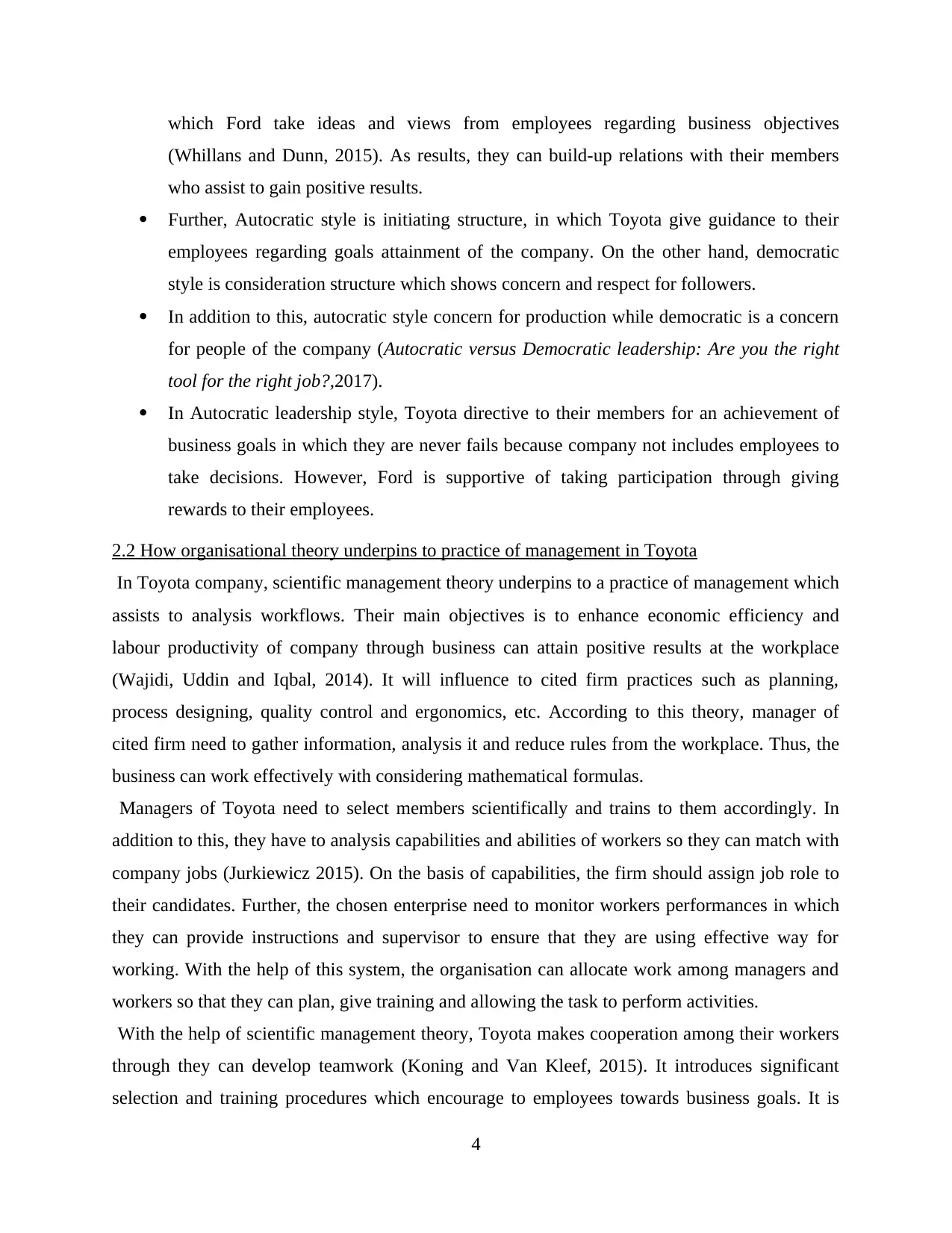
which Ford take ideas and views from employees regarding business objectives
(Whillans and Dunn, 2015). As results, they can build-up relations with their members
who assist to gain positive results.
Further, Autocratic style is initiating structure, in which Toyota give guidance to their
employees regarding goals attainment of the company. On the other hand, democratic
style is consideration structure which shows concern and respect for followers.
In addition to this, autocratic style concern for production while democratic is a concern
for people of the company (Autocratic versus Democratic leadership: Are you the right
tool for the right job?,2017).
In Autocratic leadership style, Toyota directive to their members for an achievement of
business goals in which they are never fails because company not includes employees to
take decisions. However, Ford is supportive of taking participation through giving
rewards to their employees.
2.2 How organisational theory underpins to practice of management in Toyota
In Toyota company, scientific management theory underpins to a practice of management which
assists to analysis workflows. Their main objectives is to enhance economic efficiency and
labour productivity of company through business can attain positive results at the workplace
(Wajidi, Uddin and Iqbal, 2014). It will influence to cited firm practices such as planning,
process designing, quality control and ergonomics, etc. According to this theory, manager of
cited firm need to gather information, analysis it and reduce rules from the workplace. Thus, the
business can work effectively with considering mathematical formulas.
Managers of Toyota need to select members scientifically and trains to them accordingly. In
addition to this, they have to analysis capabilities and abilities of workers so they can match with
company jobs (Jurkiewicz 2015). On the basis of capabilities, the firm should assign job role to
their candidates. Further, the chosen enterprise need to monitor workers performances in which
they can provide instructions and supervisor to ensure that they are using effective way for
working. With the help of this system, the organisation can allocate work among managers and
workers so that they can plan, give training and allowing the task to perform activities.
With the help of scientific management theory, Toyota makes cooperation among their workers
through they can develop teamwork (Koning and Van Kleef, 2015). It introduces significant
selection and training procedures which encourage to employees towards business goals. It is
4
(Whillans and Dunn, 2015). As results, they can build-up relations with their members
who assist to gain positive results.
Further, Autocratic style is initiating structure, in which Toyota give guidance to their
employees regarding goals attainment of the company. On the other hand, democratic
style is consideration structure which shows concern and respect for followers.
In addition to this, autocratic style concern for production while democratic is a concern
for people of the company (Autocratic versus Democratic leadership: Are you the right
tool for the right job?,2017).
In Autocratic leadership style, Toyota directive to their members for an achievement of
business goals in which they are never fails because company not includes employees to
take decisions. However, Ford is supportive of taking participation through giving
rewards to their employees.
2.2 How organisational theory underpins to practice of management in Toyota
In Toyota company, scientific management theory underpins to a practice of management which
assists to analysis workflows. Their main objectives is to enhance economic efficiency and
labour productivity of company through business can attain positive results at the workplace
(Wajidi, Uddin and Iqbal, 2014). It will influence to cited firm practices such as planning,
process designing, quality control and ergonomics, etc. According to this theory, manager of
cited firm need to gather information, analysis it and reduce rules from the workplace. Thus, the
business can work effectively with considering mathematical formulas.
Managers of Toyota need to select members scientifically and trains to them accordingly. In
addition to this, they have to analysis capabilities and abilities of workers so they can match with
company jobs (Jurkiewicz 2015). On the basis of capabilities, the firm should assign job role to
their candidates. Further, the chosen enterprise need to monitor workers performances in which
they can provide instructions and supervisor to ensure that they are using effective way for
working. With the help of this system, the organisation can allocate work among managers and
workers so that they can plan, give training and allowing the task to perform activities.
With the help of scientific management theory, Toyota makes cooperation among their workers
through they can develop teamwork (Koning and Van Kleef, 2015). It introduces significant
selection and training procedures which encourage to employees towards business goals. It is
4
Paraphrase This Document
Need a fresh take? Get an instant paraphrase of this document with our AI Paraphraser
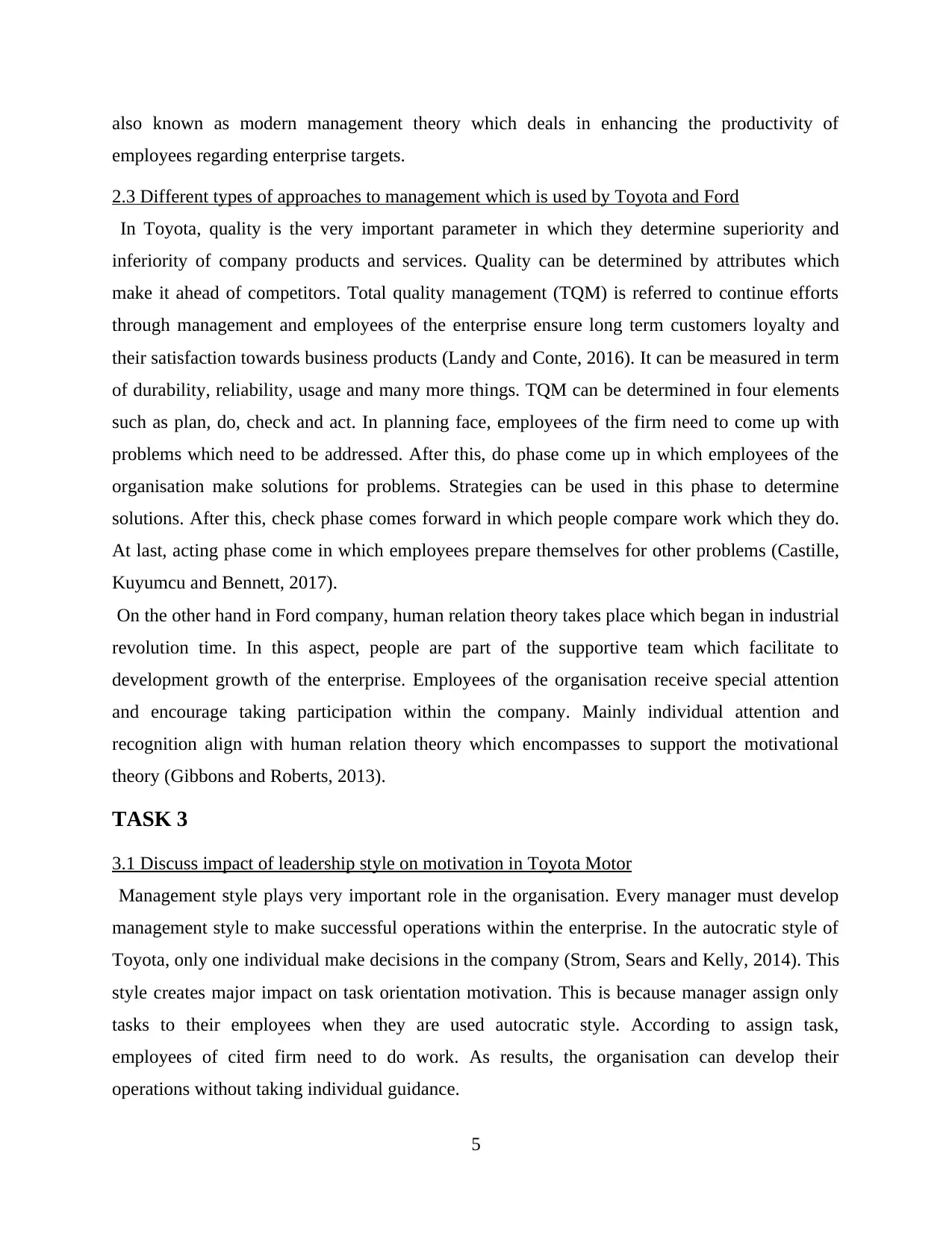
also known as modern management theory which deals in enhancing the productivity of
employees regarding enterprise targets.
2.3 Different types of approaches to management which is used by Toyota and Ford
In Toyota, quality is the very important parameter in which they determine superiority and
inferiority of company products and services. Quality can be determined by attributes which
make it ahead of competitors. Total quality management (TQM) is referred to continue efforts
through management and employees of the enterprise ensure long term customers loyalty and
their satisfaction towards business products (Landy and Conte, 2016). It can be measured in term
of durability, reliability, usage and many more things. TQM can be determined in four elements
such as plan, do, check and act. In planning face, employees of the firm need to come up with
problems which need to be addressed. After this, do phase come up in which employees of the
organisation make solutions for problems. Strategies can be used in this phase to determine
solutions. After this, check phase comes forward in which people compare work which they do.
At last, acting phase come in which employees prepare themselves for other problems (Castille,
Kuyumcu and Bennett, 2017).
On the other hand in Ford company, human relation theory takes place which began in industrial
revolution time. In this aspect, people are part of the supportive team which facilitate to
development growth of the enterprise. Employees of the organisation receive special attention
and encourage taking participation within the company. Mainly individual attention and
recognition align with human relation theory which encompasses to support the motivational
theory (Gibbons and Roberts, 2013).
TASK 3
3.1 Discuss impact of leadership style on motivation in Toyota Motor
Management style plays very important role in the organisation. Every manager must develop
management style to make successful operations within the enterprise. In the autocratic style of
Toyota, only one individual make decisions in the company (Strom, Sears and Kelly, 2014). This
style creates major impact on task orientation motivation. This is because manager assign only
tasks to their employees when they are used autocratic style. According to assign task,
employees of cited firm need to do work. As results, the organisation can develop their
operations without taking individual guidance.
5
employees regarding enterprise targets.
2.3 Different types of approaches to management which is used by Toyota and Ford
In Toyota, quality is the very important parameter in which they determine superiority and
inferiority of company products and services. Quality can be determined by attributes which
make it ahead of competitors. Total quality management (TQM) is referred to continue efforts
through management and employees of the enterprise ensure long term customers loyalty and
their satisfaction towards business products (Landy and Conte, 2016). It can be measured in term
of durability, reliability, usage and many more things. TQM can be determined in four elements
such as plan, do, check and act. In planning face, employees of the firm need to come up with
problems which need to be addressed. After this, do phase come up in which employees of the
organisation make solutions for problems. Strategies can be used in this phase to determine
solutions. After this, check phase comes forward in which people compare work which they do.
At last, acting phase come in which employees prepare themselves for other problems (Castille,
Kuyumcu and Bennett, 2017).
On the other hand in Ford company, human relation theory takes place which began in industrial
revolution time. In this aspect, people are part of the supportive team which facilitate to
development growth of the enterprise. Employees of the organisation receive special attention
and encourage taking participation within the company. Mainly individual attention and
recognition align with human relation theory which encompasses to support the motivational
theory (Gibbons and Roberts, 2013).
TASK 3
3.1 Discuss impact of leadership style on motivation in Toyota Motor
Management style plays very important role in the organisation. Every manager must develop
management style to make successful operations within the enterprise. In the autocratic style of
Toyota, only one individual make decisions in the company (Strom, Sears and Kelly, 2014). This
style creates major impact on task orientation motivation. This is because manager assign only
tasks to their employees when they are used autocratic style. According to assign task,
employees of cited firm need to do work. As results, the organisation can develop their
operations without taking individual guidance.
5
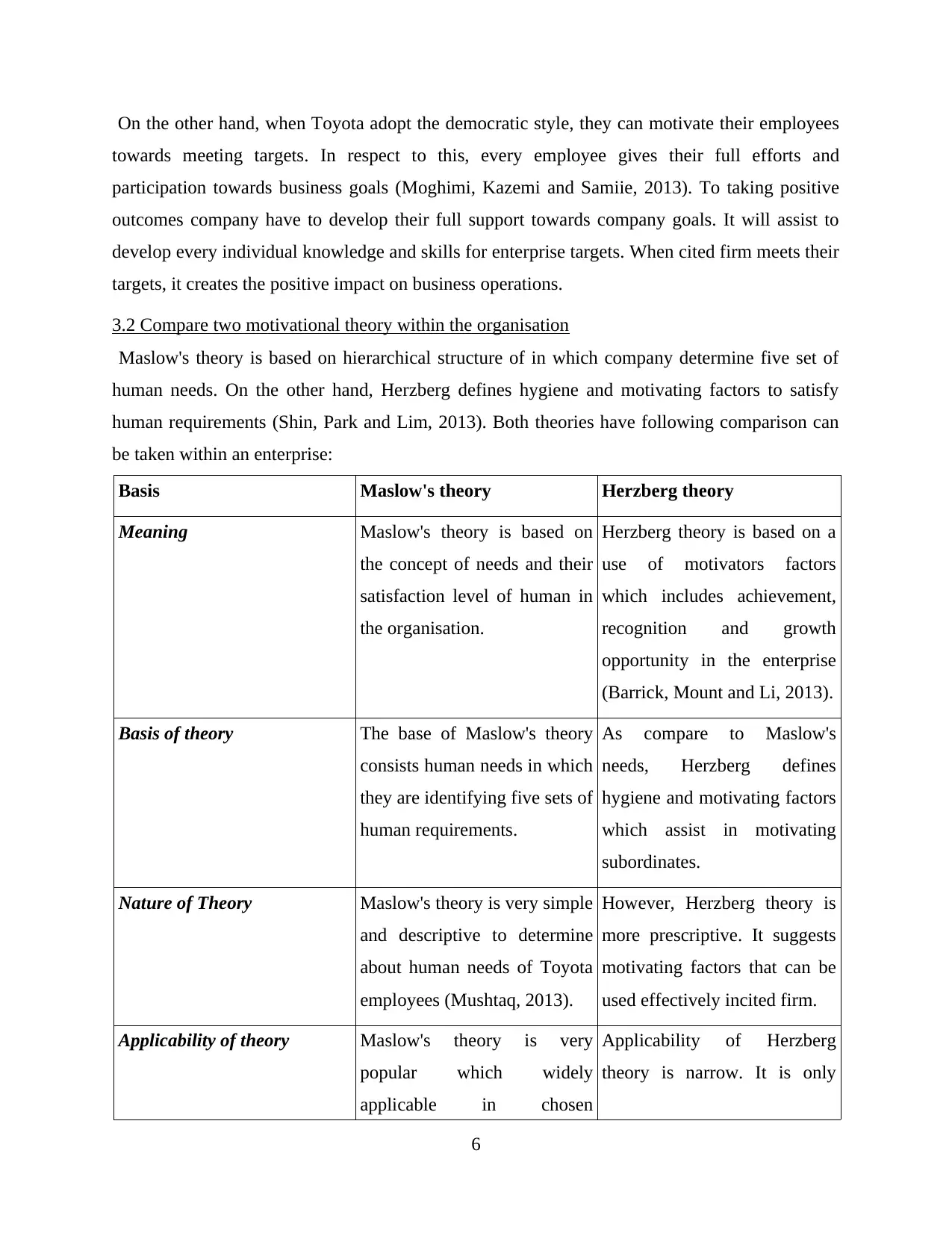
On the other hand, when Toyota adopt the democratic style, they can motivate their employees
towards meeting targets. In respect to this, every employee gives their full efforts and
participation towards business goals (Moghimi, Kazemi and Samiie, 2013). To taking positive
outcomes company have to develop their full support towards company goals. It will assist to
develop every individual knowledge and skills for enterprise targets. When cited firm meets their
targets, it creates the positive impact on business operations.
3.2 Compare two motivational theory within the organisation
Maslow's theory is based on hierarchical structure of in which company determine five set of
human needs. On the other hand, Herzberg defines hygiene and motivating factors to satisfy
human requirements (Shin, Park and Lim, 2013). Both theories have following comparison can
be taken within an enterprise:
Basis Maslow's theory Herzberg theory
Meaning Maslow's theory is based on
the concept of needs and their
satisfaction level of human in
the organisation.
Herzberg theory is based on a
use of motivators factors
which includes achievement,
recognition and growth
opportunity in the enterprise
(Barrick, Mount and Li, 2013).
Basis of theory The base of Maslow's theory
consists human needs in which
they are identifying five sets of
human requirements.
As compare to Maslow's
needs, Herzberg defines
hygiene and motivating factors
which assist in motivating
subordinates.
Nature of Theory Maslow's theory is very simple
and descriptive to determine
about human needs of Toyota
employees (Mushtaq, 2013).
However, Herzberg theory is
more prescriptive. It suggests
motivating factors that can be
used effectively incited firm.
Applicability of theory Maslow's theory is very
popular which widely
applicable in chosen
Applicability of Herzberg
theory is narrow. It is only
6
towards meeting targets. In respect to this, every employee gives their full efforts and
participation towards business goals (Moghimi, Kazemi and Samiie, 2013). To taking positive
outcomes company have to develop their full support towards company goals. It will assist to
develop every individual knowledge and skills for enterprise targets. When cited firm meets their
targets, it creates the positive impact on business operations.
3.2 Compare two motivational theory within the organisation
Maslow's theory is based on hierarchical structure of in which company determine five set of
human needs. On the other hand, Herzberg defines hygiene and motivating factors to satisfy
human requirements (Shin, Park and Lim, 2013). Both theories have following comparison can
be taken within an enterprise:
Basis Maslow's theory Herzberg theory
Meaning Maslow's theory is based on
the concept of needs and their
satisfaction level of human in
the organisation.
Herzberg theory is based on a
use of motivators factors
which includes achievement,
recognition and growth
opportunity in the enterprise
(Barrick, Mount and Li, 2013).
Basis of theory The base of Maslow's theory
consists human needs in which
they are identifying five sets of
human requirements.
As compare to Maslow's
needs, Herzberg defines
hygiene and motivating factors
which assist in motivating
subordinates.
Nature of Theory Maslow's theory is very simple
and descriptive to determine
about human needs of Toyota
employees (Mushtaq, 2013).
However, Herzberg theory is
more prescriptive. It suggests
motivating factors that can be
used effectively incited firm.
Applicability of theory Maslow's theory is very
popular which widely
applicable in chosen
Applicability of Herzberg
theory is narrow. It is only
6
⊘ This is a preview!⊘
Do you want full access?
Subscribe today to unlock all pages.

Trusted by 1+ million students worldwide
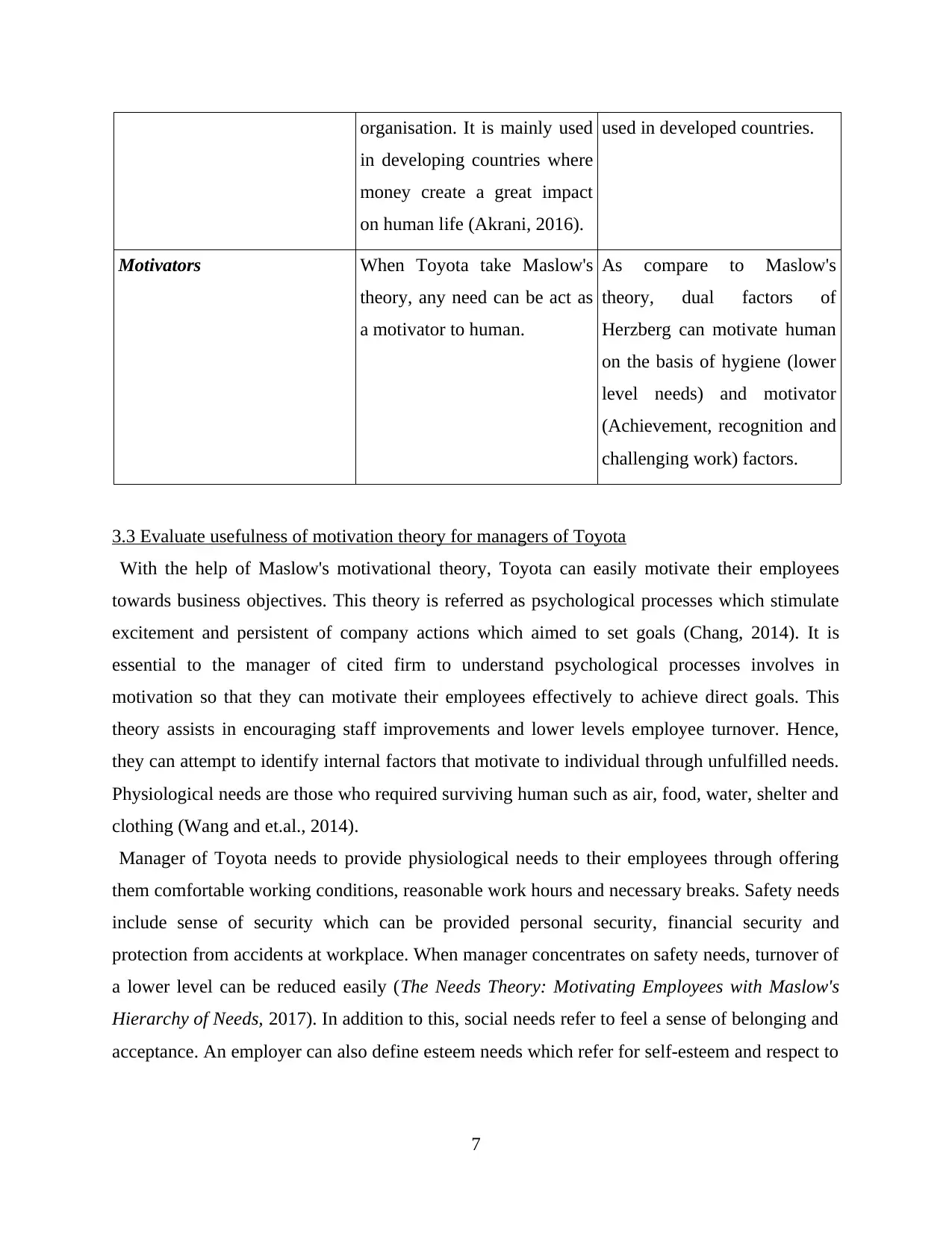
organisation. It is mainly used
in developing countries where
money create a great impact
on human life (Akrani, 2016).
used in developed countries.
Motivators When Toyota take Maslow's
theory, any need can be act as
a motivator to human.
As compare to Maslow's
theory, dual factors of
Herzberg can motivate human
on the basis of hygiene (lower
level needs) and motivator
(Achievement, recognition and
challenging work) factors.
3.3 Evaluate usefulness of motivation theory for managers of Toyota
With the help of Maslow's motivational theory, Toyota can easily motivate their employees
towards business objectives. This theory is referred as psychological processes which stimulate
excitement and persistent of company actions which aimed to set goals (Chang, 2014). It is
essential to the manager of cited firm to understand psychological processes involves in
motivation so that they can motivate their employees effectively to achieve direct goals. This
theory assists in encouraging staff improvements and lower levels employee turnover. Hence,
they can attempt to identify internal factors that motivate to individual through unfulfilled needs.
Physiological needs are those who required surviving human such as air, food, water, shelter and
clothing (Wang and et.al., 2014).
Manager of Toyota needs to provide physiological needs to their employees through offering
them comfortable working conditions, reasonable work hours and necessary breaks. Safety needs
include sense of security which can be provided personal security, financial security and
protection from accidents at workplace. When manager concentrates on safety needs, turnover of
a lower level can be reduced easily (The Needs Theory: Motivating Employees with Maslow's
Hierarchy of Needs, 2017). In addition to this, social needs refer to feel a sense of belonging and
acceptance. An employer can also define esteem needs which refer for self-esteem and respect to
7
in developing countries where
money create a great impact
on human life (Akrani, 2016).
used in developed countries.
Motivators When Toyota take Maslow's
theory, any need can be act as
a motivator to human.
As compare to Maslow's
theory, dual factors of
Herzberg can motivate human
on the basis of hygiene (lower
level needs) and motivator
(Achievement, recognition and
challenging work) factors.
3.3 Evaluate usefulness of motivation theory for managers of Toyota
With the help of Maslow's motivational theory, Toyota can easily motivate their employees
towards business objectives. This theory is referred as psychological processes which stimulate
excitement and persistent of company actions which aimed to set goals (Chang, 2014). It is
essential to the manager of cited firm to understand psychological processes involves in
motivation so that they can motivate their employees effectively to achieve direct goals. This
theory assists in encouraging staff improvements and lower levels employee turnover. Hence,
they can attempt to identify internal factors that motivate to individual through unfulfilled needs.
Physiological needs are those who required surviving human such as air, food, water, shelter and
clothing (Wang and et.al., 2014).
Manager of Toyota needs to provide physiological needs to their employees through offering
them comfortable working conditions, reasonable work hours and necessary breaks. Safety needs
include sense of security which can be provided personal security, financial security and
protection from accidents at workplace. When manager concentrates on safety needs, turnover of
a lower level can be reduced easily (The Needs Theory: Motivating Employees with Maslow's
Hierarchy of Needs, 2017). In addition to this, social needs refer to feel a sense of belonging and
acceptance. An employer can also define esteem needs which refer for self-esteem and respect to
7
Paraphrase This Document
Need a fresh take? Get an instant paraphrase of this document with our AI Paraphraser
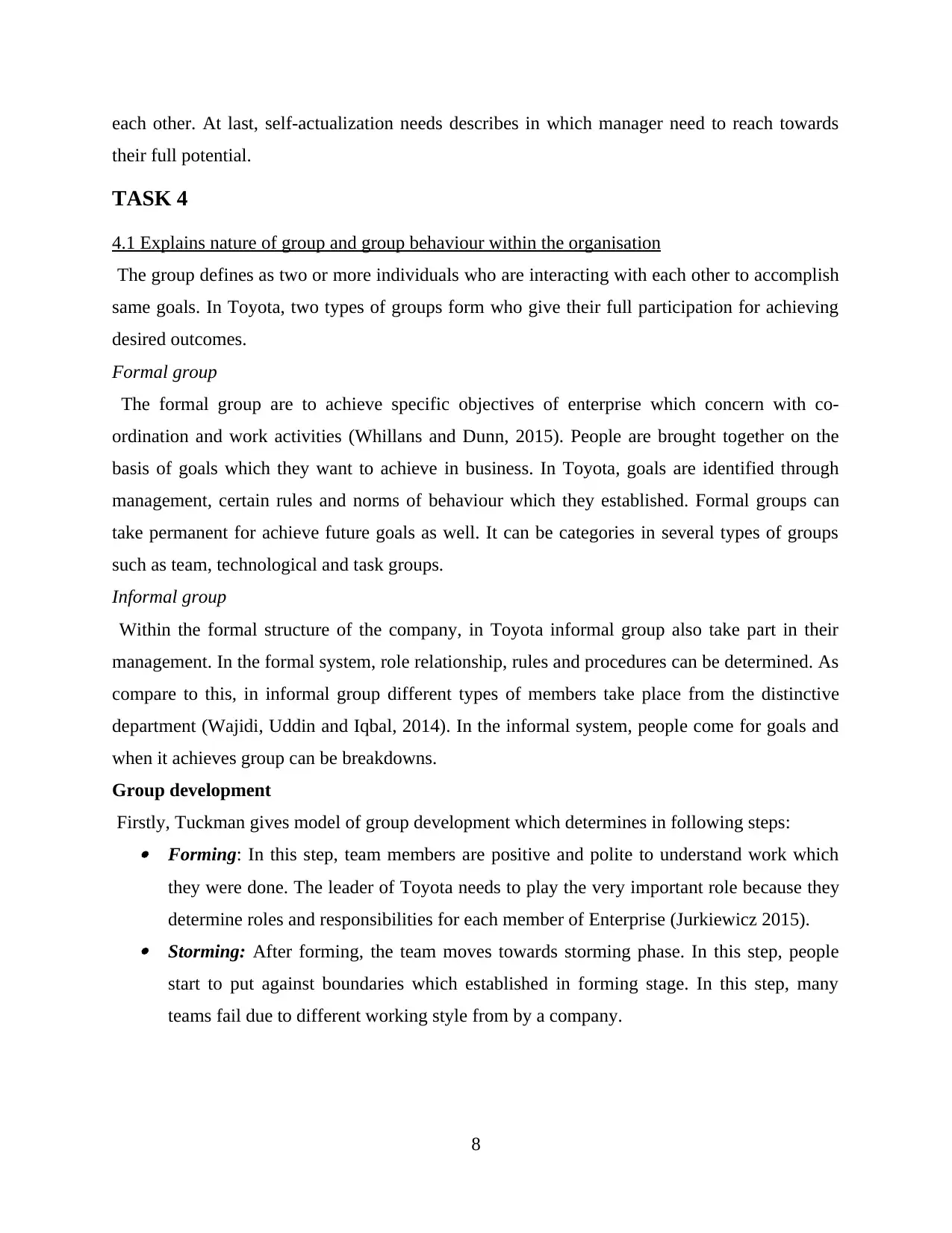
each other. At last, self-actualization needs describes in which manager need to reach towards
their full potential.
TASK 4
4.1 Explains nature of group and group behaviour within the organisation
The group defines as two or more individuals who are interacting with each other to accomplish
same goals. In Toyota, two types of groups form who give their full participation for achieving
desired outcomes.
Formal group
The formal group are to achieve specific objectives of enterprise which concern with co-
ordination and work activities (Whillans and Dunn, 2015). People are brought together on the
basis of goals which they want to achieve in business. In Toyota, goals are identified through
management, certain rules and norms of behaviour which they established. Formal groups can
take permanent for achieve future goals as well. It can be categories in several types of groups
such as team, technological and task groups.
Informal group
Within the formal structure of the company, in Toyota informal group also take part in their
management. In the formal system, role relationship, rules and procedures can be determined. As
compare to this, in informal group different types of members take place from the distinctive
department (Wajidi, Uddin and Iqbal, 2014). In the informal system, people come for goals and
when it achieves group can be breakdowns.
Group development
Firstly, Tuckman gives model of group development which determines in following steps: Forming: In this step, team members are positive and polite to understand work which
they were done. The leader of Toyota needs to play the very important role because they
determine roles and responsibilities for each member of Enterprise (Jurkiewicz 2015). Storming: After forming, the team moves towards storming phase. In this step, people
start to put against boundaries which established in forming stage. In this step, many
teams fail due to different working style from by a company.
8
their full potential.
TASK 4
4.1 Explains nature of group and group behaviour within the organisation
The group defines as two or more individuals who are interacting with each other to accomplish
same goals. In Toyota, two types of groups form who give their full participation for achieving
desired outcomes.
Formal group
The formal group are to achieve specific objectives of enterprise which concern with co-
ordination and work activities (Whillans and Dunn, 2015). People are brought together on the
basis of goals which they want to achieve in business. In Toyota, goals are identified through
management, certain rules and norms of behaviour which they established. Formal groups can
take permanent for achieve future goals as well. It can be categories in several types of groups
such as team, technological and task groups.
Informal group
Within the formal structure of the company, in Toyota informal group also take part in their
management. In the formal system, role relationship, rules and procedures can be determined. As
compare to this, in informal group different types of members take place from the distinctive
department (Wajidi, Uddin and Iqbal, 2014). In the informal system, people come for goals and
when it achieves group can be breakdowns.
Group development
Firstly, Tuckman gives model of group development which determines in following steps: Forming: In this step, team members are positive and polite to understand work which
they were done. The leader of Toyota needs to play the very important role because they
determine roles and responsibilities for each member of Enterprise (Jurkiewicz 2015). Storming: After forming, the team moves towards storming phase. In this step, people
start to put against boundaries which established in forming stage. In this step, many
teams fail due to different working style from by a company.
8
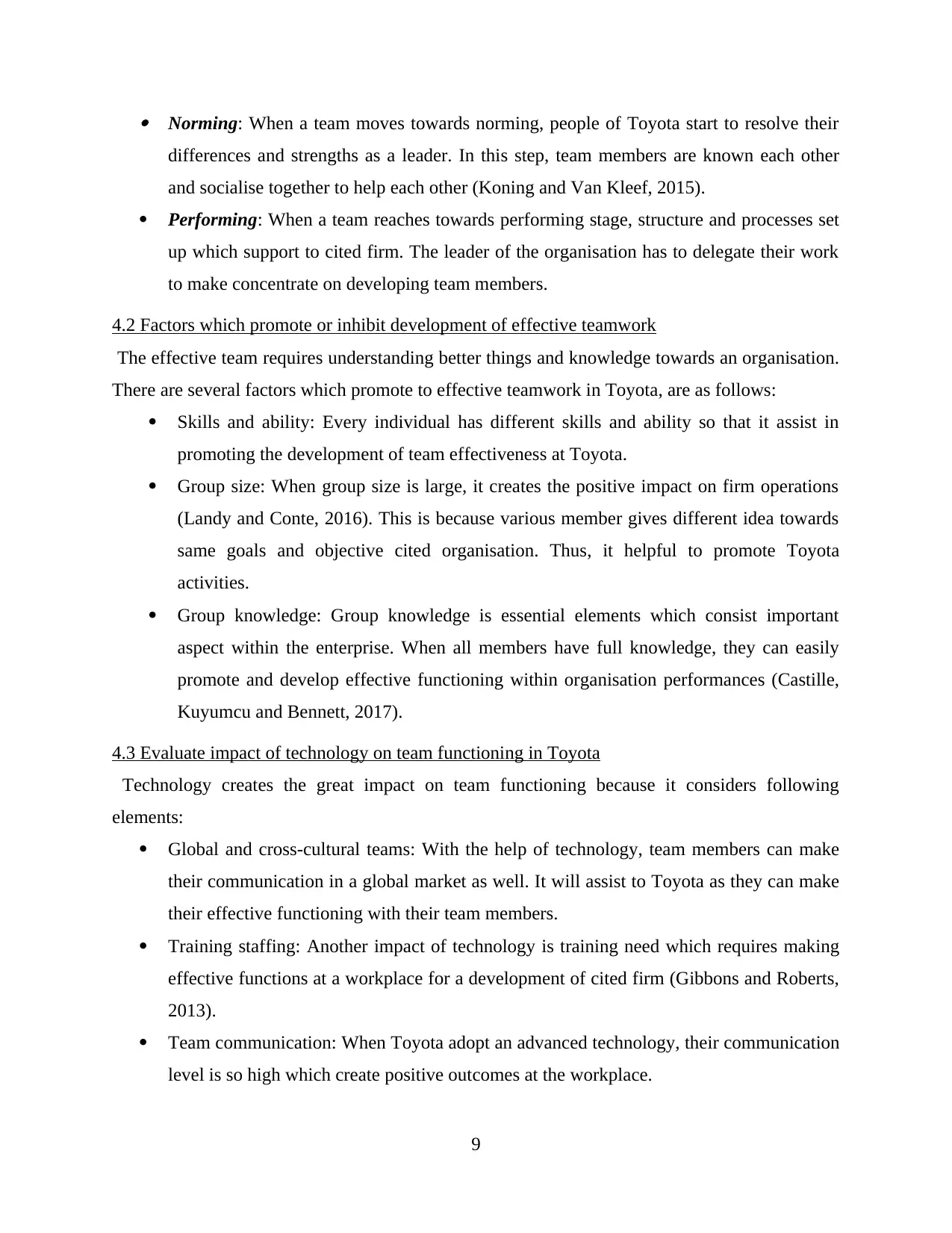
Norming: When a team moves towards norming, people of Toyota start to resolve their
differences and strengths as a leader. In this step, team members are known each other
and socialise together to help each other (Koning and Van Kleef, 2015).
Performing: When a team reaches towards performing stage, structure and processes set
up which support to cited firm. The leader of the organisation has to delegate their work
to make concentrate on developing team members.
4.2 Factors which promote or inhibit development of effective teamwork
The effective team requires understanding better things and knowledge towards an organisation.
There are several factors which promote to effective teamwork in Toyota, are as follows:
Skills and ability: Every individual has different skills and ability so that it assist in
promoting the development of team effectiveness at Toyota.
Group size: When group size is large, it creates the positive impact on firm operations
(Landy and Conte, 2016). This is because various member gives different idea towards
same goals and objective cited organisation. Thus, it helpful to promote Toyota
activities.
Group knowledge: Group knowledge is essential elements which consist important
aspect within the enterprise. When all members have full knowledge, they can easily
promote and develop effective functioning within organisation performances (Castille,
Kuyumcu and Bennett, 2017).
4.3 Evaluate impact of technology on team functioning in Toyota
Technology creates the great impact on team functioning because it considers following
elements:
Global and cross-cultural teams: With the help of technology, team members can make
their communication in a global market as well. It will assist to Toyota as they can make
their effective functioning with their team members.
Training staffing: Another impact of technology is training need which requires making
effective functions at a workplace for a development of cited firm (Gibbons and Roberts,
2013).
Team communication: When Toyota adopt an advanced technology, their communication
level is so high which create positive outcomes at the workplace.
9
differences and strengths as a leader. In this step, team members are known each other
and socialise together to help each other (Koning and Van Kleef, 2015).
Performing: When a team reaches towards performing stage, structure and processes set
up which support to cited firm. The leader of the organisation has to delegate their work
to make concentrate on developing team members.
4.2 Factors which promote or inhibit development of effective teamwork
The effective team requires understanding better things and knowledge towards an organisation.
There are several factors which promote to effective teamwork in Toyota, are as follows:
Skills and ability: Every individual has different skills and ability so that it assist in
promoting the development of team effectiveness at Toyota.
Group size: When group size is large, it creates the positive impact on firm operations
(Landy and Conte, 2016). This is because various member gives different idea towards
same goals and objective cited organisation. Thus, it helpful to promote Toyota
activities.
Group knowledge: Group knowledge is essential elements which consist important
aspect within the enterprise. When all members have full knowledge, they can easily
promote and develop effective functioning within organisation performances (Castille,
Kuyumcu and Bennett, 2017).
4.3 Evaluate impact of technology on team functioning in Toyota
Technology creates the great impact on team functioning because it considers following
elements:
Global and cross-cultural teams: With the help of technology, team members can make
their communication in a global market as well. It will assist to Toyota as they can make
their effective functioning with their team members.
Training staffing: Another impact of technology is training need which requires making
effective functions at a workplace for a development of cited firm (Gibbons and Roberts,
2013).
Team communication: When Toyota adopt an advanced technology, their communication
level is so high which create positive outcomes at the workplace.
9
⊘ This is a preview!⊘
Do you want full access?
Subscribe today to unlock all pages.

Trusted by 1+ million students worldwide
1 out of 15
Related Documents
Your All-in-One AI-Powered Toolkit for Academic Success.
+13062052269
info@desklib.com
Available 24*7 on WhatsApp / Email
![[object Object]](/_next/static/media/star-bottom.7253800d.svg)
Unlock your academic potential
Copyright © 2020–2025 A2Z Services. All Rights Reserved. Developed and managed by ZUCOL.





